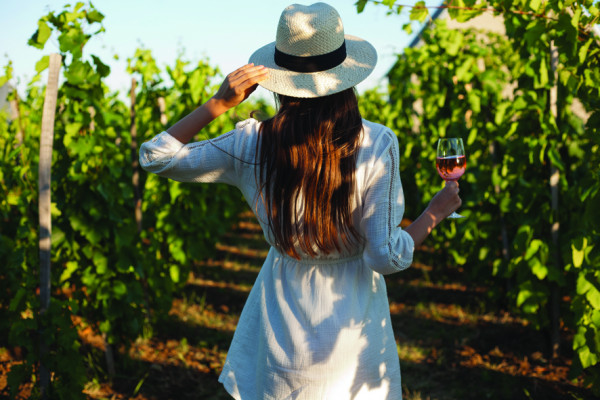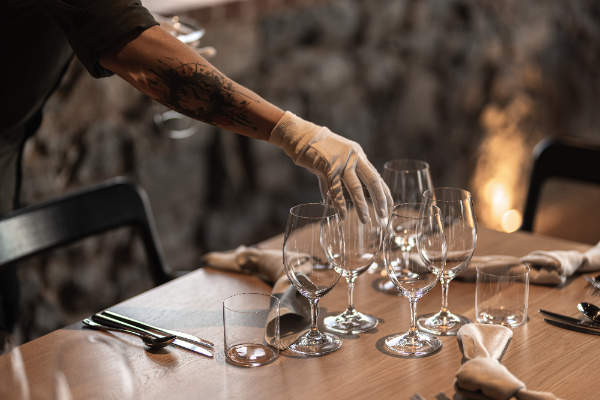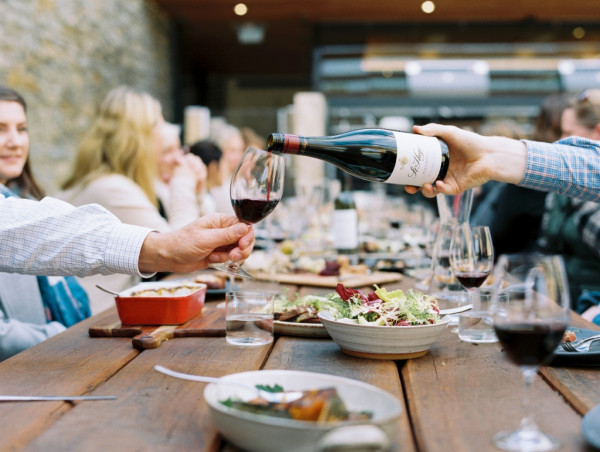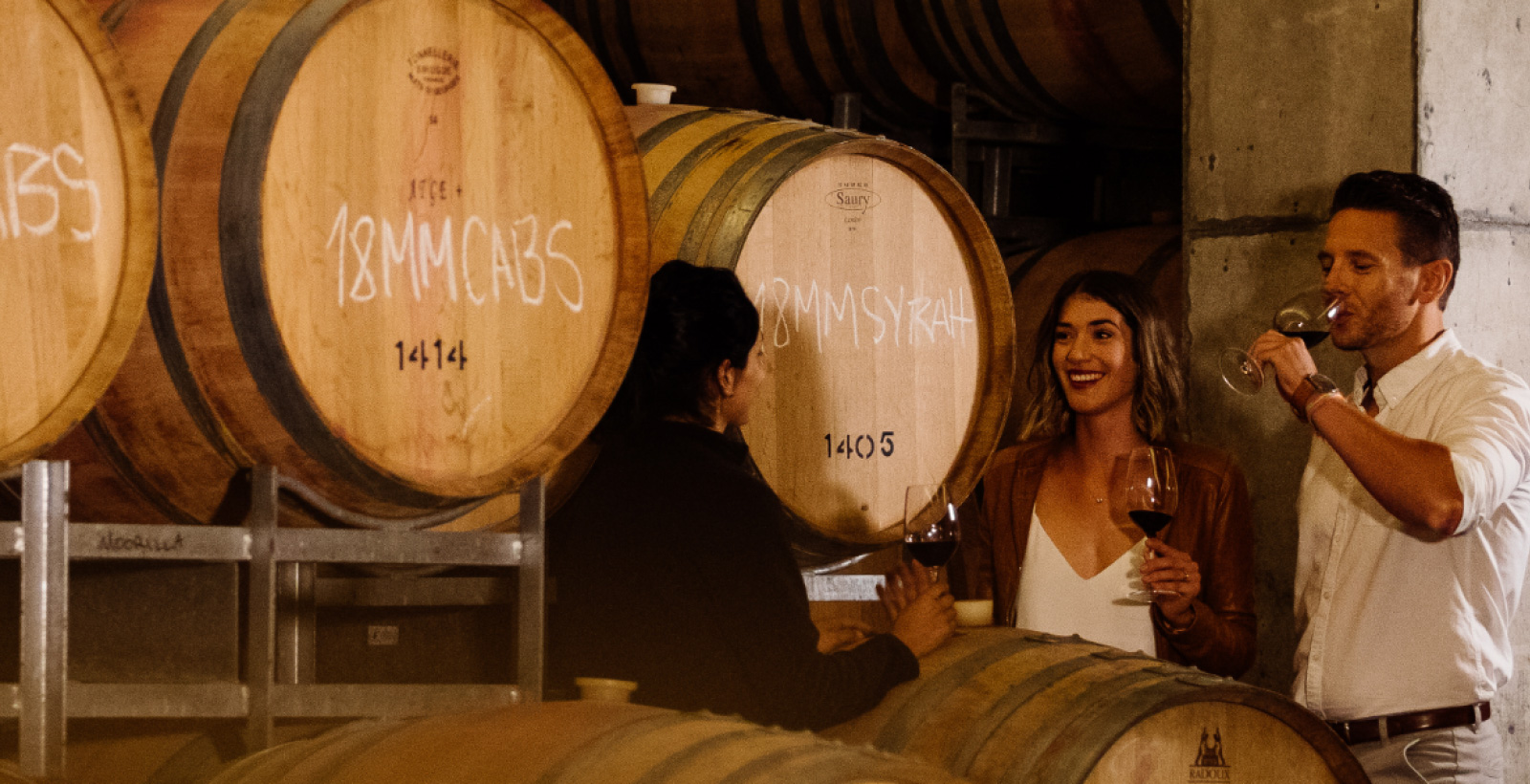Drink The Very Best Wine In Australia For Global Wine Day
-
Author Inspiring Journeys
-
Date 18 Feb 2022
EXPLORING THE BEST WINE IN AUSTRALIA
WHILE the indigenous palawa people have long enjoyed ‘Way-a-linah’, a drink made from the fermented sap of the cider gum tree found in Tasmania’s high country, Australia’s wine story is a little more recent, dating back to the first tall ships bringing English settlers carried a collection of vines that went into the ground around Sydney Cove.
These plants, gathered when British vessels were surveying destinations across South America and southern Africa, failed to thrive in the hot and humid conditions of the antipodean summer but laid the foundations for an enviable industry that now counts 100 different grape varieties in its catalogue.
Today, 234 years later, Australia is the world’s fourth-largest exporter of wine by volume behind traditional producing powerhouses like Italy and France sending almost 700 million litres – or 60 per cent of total production – across the seas in an average year.
Industry insiders estimate there are now 2100 wineries and 6000 vineyards across the country’s 65 grape-growing regions.
So, on Global Wine Day, let’s take a wander through Australia’s wine-making history and visit the top grape-growing regions that accommodate estates now considered to be the very best in this world-class business.
BUT FIRST, HOW DID IT HAPPEN?
Australian connoisseurs can thank James Busby for the wine produced around Australia today, with this early incarnation of the modern-day viticulturalist travelling to Europe in the 1830s to collect 650 varieties and bring them back to Sydney.
More than half survived the journey to be planted across the undulating terrain that is now the site of Sydney’s Royal Botanic Gardens and around his Hunter Valley property, with cuttings travelling to other corners of New South Wales as well as Victoria and South Australia.
The Hunter Valley became the first commercial wine region, when Wyndham Estate was born in 1828, and just two decades later wineries were also thriving in South Australia’s Barossa Valley and around Victoria’s Mornington Peninsula.
A little short of two centuries later and Australia is, according to Wine Australia, home to “one of the most diverse wine scenes in the world” with our varieties “an expression of the country’s distinctive climates and soils, and the passionate communities that cultivate them”.
“The Australian wine community is renowned for its creativity and willingness to experiment (and) winemakers are curious by nature, perfecting old concepts and playing with new ideas to create outstanding wines,” it is noted in the organisation’s publication Foundations of Australian Wine.
“Winemakers take a down-to-earth approach, reflecting the beauty of Australia’s ancient soils and varied climate, (and) many vineyards are cultivated by multi-generational wine families.”
IT’S ALL ABOUT GEOGRAPHY
As we roll into the second decade of the new century wine is being made in each of Australia’s six states and two territories with manufacturing focused through the lower latitudes where temperatures are the coolest, sunshine the smoothest, air the freshest, and rains the most reliable.
“In the southern regions, where vineyards are concentrated, the cold and stormy Southern Ocean keeps temperatures cool and contributes to an ideal climate for producing wine,” the Wine Australia guide explains.
“In addition to these cool-climate credentials, the world’s purest air blows over the southern shores of Australia, and low population density and rigorous environmental controls combine to produce quality grapes free from industrial and urban pollution.”
Near 145,000ha of Australia is currently under vine – that’s slightly less than Bordeaux and Burgundy combined – with maritime influences, agreeable elevation and sun-catching latitudes matching “a surprising diversity of climates with extremely variable rainfalls” to foster world-class conditions.
From Perth’s Swan Valley in the west to Hastings River on the New South Wales coast, and from South Burnett in an elevated corner of south-east Queensland to Tasmania’s chilled Coal River Valley, here are the most prominent names when it comes to sorting Australia’s best wine regions.
MARGARET RIVER

A Mediterranean climate with solid maritime influences – yes, those delightful Indian Ocean breezes that wash across Western Australia’s scenic south-west corner – combine to create Margaret River’s signature Cabernet Sauvignon, Chardonnay, Shiraz and SSB blends.
Famous names like Evans & Tate, Leeuwin Estate, Robert Oatley, Vasse Felix and Voyager Estate are the region’s big players but these legends are just the start with almost 150 vineyards, wineries and cellar doors sitting beside the old-growth forests a three-hour drive south from Perth.
Next stop: The diverse and dynamic Geographe region – which follows the curve of Geographe Bay – shares a boundary with Margaret River and is home to family-run wineries refining Cabernet Sauvignon, Sauvignon Blanc, Semillon and Shiraz bottles that are warmly welcomed overseas.
BAROSSA VALLEY

South Australia’s Barossa Valley is celebrated for leading the way in taking premium Australian wines to the world and is now home to sixth-generation growers, some of the world’s oldest vines and more than 150 estates that continue to invest in innovation.
The rolling hills an hour’s drive north from Adelaide are a patchwork of vineyards with the wet winters and dry summers that bring lots of sunshine and minimal humidity nurturing the Cabernet Sauvignon, Grenache and Shiraz varieties that have morphed into the region’s calling card.
Next stop: The Clare Valley sits a dawdle to the north of the Barossa in the spectacular Mount Lofty Ranges, with the boutique wine region providing a Riesling that’s now credited with setting the benchmark for the variety in Australia and investing in new-world reds like Grenache, Malbec, Mourvedre and Tempranillo.
MCLAREN VALE
Wine Australia credits this historic South Australian district as being home “to one of the most progressive and environmentally conscious wine communities in Australia” with a Shiraz that’s famous for “velvety texture and intense berry flavours” the region’s signature.
But it doesn’t end there with the waterside climate – Mediterranean, warm summers, mild winters, reliable mid-year rains – also nurturing the Grenache that is blossoming into the zone’s newest star performer and a Cabernet Sauvignon that collectors are encouraged to cellar for a few decades.
Next stop: Kangaroo Island is getting back on its feet, after the fierce bushfires of the 2019/20 summer destroyed more than 70 per cent of this previously-perfect parcel, with grape growers moving on from that lost vintage to build a reputation for crafting elegant Cabernet blends that thrive during the extended ripening window.
YARRA VALLEY
Victoria’s bucolic Yarra Valley, stretching from the outskirts of Melbourne’s eastern suburbs to the foothills of the Great Dividing Range, is such a diverse district it boasts dozens of microclimates creating classic styles and new-world selections.
The Valley is considered to be a pioneer in modern Pinot Noir, there are two main styles of Shiraz from bold and rich to light and savoury, Chardonnay is produced in many different styles but are typically fresh with citrus acidity, and Cabernet Sauvignon is credited with being a little lighter than those grown in warmer blocks.
Next stop: Sunbury, a tour across the top of Melbourne from the Yarra Valley, is not your typical Australian wine region with the historic settlement that’s now more outer suburb than country town home to a cute cluster of heritage estates growing Chardonnay, Shiraz and Viognier that carry hefty price tags.
HUNTER VALLEY

The birthplace of Australian wine – thanks to the European holiday James Busby took back in 1831 – never fails to impress with dozens of cellar doors showcasing the hero Chardonnay, Semillon, Shiraz and Verdelho varieties made by a band of industry legends and innovative newcomers.
More than 2600ha of land in the foothills of the Brokenback Range are now under vine with summer rains, matched with cold nights during autumn and winter, proving to be the ideal blend for new-world varieties like Barbera, Montepulciano, Sangiovese, Tempranillo and Vermentino.
Next stop: New England sits a little to the north of the Hunter Valley and rolls up to the Queensland border, with the area supporting a thriving wine industry since the 1800s and legendary for Chardonnay, Riesling and Shiraz as well as new-world names like Gewurztraminer, Nebbiolo and Tempranillo.
TAMAR VALLEY
While Josef Chromy Wines is the most famous name in Tasmania’s oldest and most significant wine district, it is far from the only address with boutique and bolthole estates carpeting the undulating terrain that flanks the curves of the majestic Tamar River as it winds towards Launceston.
This region officially wears a cold-climate classification – providing the perfect conditions to support the signature Pinot Noir and Sauvignon Blanc varieties – but is dependably warmer and drier than some spots in southern Victoria and using that position to also produce sparkling created from Chardonnay and Pinot grapes.
Next stop: Tasmania’s size means it’s easy to do several of the seven distinct wine regions during one short visit, with Piper River and the North West neighbouring the Tamar Valley and the East Coast area stretching north and south from the Freycinet Peninsula. Coal River Valley and Derwent Valley surround Hobart, making these zones ready for day tours from the capital, while Huon wraps around Cygnet to make it the country’s most southerly zone.
BEST WINE AUSTRALIA IS NOT ONLY ABOUT BIG NAMES
The iconic wine regions will always top the travel to-do list of established and emerging wine enthusiasts, but there are a few under-the-radar addresses that are far from the tramped tourist trail and set to step from the wine-making shadows.
Sampling superb Riesling while getting lost in nature are on the agenda for those visiting South Australia’s Eden Valley, which hides high in the hills beside the Barossa, while the King Valleys rests deep in Victoria’s alpine heart and boasts an Italian heritage that sees the spot celebrated as the birthplace of Australian Prosecco.
Queensland’s southern border is home to the Granite Belt where 50 cellar doors display drops shaped by a “mountainous pocket of cool” while Orange in central NSW is a cool-climate region that’s “on the rise” thanks to the lofty vineyards growing the hero crisp or creamy Chardonnay.
The Great Southern, stretching across Western Australia’s vast maritime Southern Ocean boundary, was given the nod as one of Australia’s top grape-growing regions during the middle of the past century and now quietly cultivates some of the state’s best bottles including Chardonnay and Riesling.
Neighbouring Pemberton is another hidden gem, and another of the country’s exciting young wine regions, with a handful of estates lining the misty valleys creating memorable Merlots and Pinot Noirs.
Wine lovers exploring Victoria should visit the Geelong region which is the least famous of the three areas making up the state’s cast southern Pinot Coast, The Grampians is building a name by nurturing a spicy Shiraz, and Rutherglen in the riparian north is a favourite with fans of fortified varieties.
SAVOUR WINE COUNTRY WITH INSPIRING JOURNEYS
South Australians celebrate the fact red, white and fortified drops are cultivated in all of the state’s 18 districts with this impressive inventory helping earn the destination the title of Great Wine Capital of Australia and becoming a target for tourists looking to indulge in a tipple or two during their travels.
Inspiring Journeys – the AAT Kings sister brand that invites travellers to join small-group journeys that embark on bespoke explorations around Australia and New Zealand – has created a hosted holiday that ambles across the state to sample some of this iconic South Australian “wine country”.
Flavours of South Australia is a thoughtful five-day itinerary that completes a clockwise loop from Adelaide to take in the Barossa Valley, Adelaide Hills and McLaren Vale regions with Penfolds, Seppeltsfield, St Hugo’s Winery, d’Arenberg and Gemtree Wines some estates on the schedule.
But this expedition is about gourmet goodies as well as fine wine with ample time to meet the makers, growers and producers behind South Australia’s stellar food scene. The relaxed route included a visit to Adelaide’s Central Market, Maggie Beer’s Farm Shop and Provenance Barossa.
Tempted? We thought you might be.

